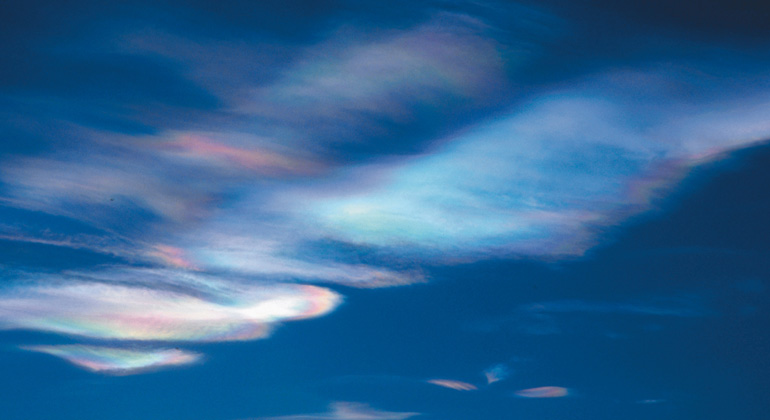Unusual cold spell in the stratosphere creates conditions for severe ozone depletion in the Arctic
AWI researchers measure temperatures of minus 90 degrees Celsius and lower at 20 kilometres altitude.
Unusual weather development in the Arctic leads to ozone depletion. According to the researchers of the Alfred Wegener Institute, Helmholtz Centre for Polar and Marine Research (AWI) in the past weeks an extreme cold spell in the Arctic stratosphere has created conditions that might cause severe ozone depletion over the Arctic in March – if the next few weeks will not bring a significant warming.
“At about 20 kilometres altitude over the Arctic, the air has been as cold as minus 90 degrees Celsius for weeks,” explains AWI atmospheric researcher Dr Marion Maturilli. “Since the beginning of December, above our Arctic research station on Spitsbergen the mean temperature in the stratosphere has been eight degrees Celsius below the long-term average and two degrees Celsius below the previous minimum. These are conditions that can result in substantial ozone depletion.”
The depletion of the ozone layer is caused by chlorofluorocarbons, which humankind has released in large quantities over the past decades. Their breakdown products attack the ozone layer, especially after prolonged periods of extreme cold.
Such cold spells usually only occur in the Antarctic winter, which is why an ozone hole forms over the Antarctic every year in spring. “In the Arctic, on the other hand, the temperatures in the stratosphere are usually higher and much more variable, which means that ozone depletion is limited. Here, severe ozone losses only occur following periods of particularly low temperatures, which we have experienced only very rarely – for example after the cold stratospheric winter of 2010/2011. At that time, ozone depletion also led to a pronounced minimum over the northern hemisphere,” says AWI researcher Dr Markus Rex, the coordinator of the EU funded project StratoClim, which observes the situation in the Arctic closely.
Conditions created by stable low-pressure vortex
Model calculations performed by AWI researchers based on the extreme cold spell in recent weeks show that the chemical conditions in the Arctic stratosphere already now exceed the ozone depletion potential of the 2010/2011 winter. “The air masses with these unusual conditions are currently caught in a low-pressure vortex high over the Arctic. Transport of ozone into the vortex has also been low and an ozone minimum has already started to develop. By mid-February more than a quarter of the total ozone above the Arctic will have been destroyed chemically. At that time ozone depletion within the vortex will gain momentum when more intense solar light returns to the Arctic at the end of the polar night,” according to Markus Rex. “Should the vortex persist until well into March, the formation of a deep ozone minimum over the Arctic has to be expected. However, if the vortex breaks up before then, the air masses will sufficiently mix with fresh air from lower latitudes and the Arctic will narrowly avoid a new record of ozone depletion,” the researcher explains.
The scientists are not currently able to reliably predict the fate of the vortex beyond late February and whether it will break up in time. If a pronounced ozone minimum does develop, there is a chance, that it will drift over Central Europe. In order to closely follow the ozone loss over the Arctic, the StratoClim consortium, together with further international collaborators, is sending hundreds of ozone sensors into the stratosphere from a network of 30 observation stations in an on-going coordinated effort. Furthermore, measurement flights into the Arctic stratosphere with a high-altitude research aircraft are planned for early April.
Cooling of the stratosphere is a consequence of global climate change
“We are expecting a general cooling of the stratosphere as a result of global climate change. The mechanisms that regulate the temperatures of the Arctic stratosphere, however, are complicated and not fully understood. Whether the record low temperatures in the past weeks are linked to climate change is therefore the subject of active research,” says Markus Rex.
The production of ozone-depleting CFCs is now banned worldwide by the Montreal Protocol. In the long term, the ozone layer is therefore expected to make a full recovery by the end of the century. “The current unusual situation in the Arctic does not change this positive outlook, even if a record ozone loss over the Arctic should occur this spring,” says Markus Rex.
These impressive results probably make the Montreal Protocol the most successful international treaty for the protection of the global environment. However: “Unfortunately, the CFCs already released cannot be removed from the atmosphere and their natural breakdown in the atmosphere is very slow. During the next one to two decades, following unusual cold spells, the Arctic stratosphere will therefore remain susceptible to severe ozone losses,” the AWI expert explains.
Original Publication
Related Science article: Record ozone hole may open over Arctic in the spring – DOI:10.1126/science.aaf4033
Source
Alfred Wegener Institute, Helmholtz Centre for Polar and Marine Research 2016








